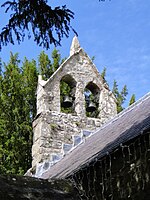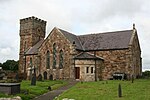The Old Church of St Nidan, Llanidan is a medieval church in the community of Llanidan, in Anglesey, North Wales, close to the Menai Strait. The first church on the site was established in the 7th century by St Nidan, the confessor of the monastery at Penmon, Anglesey, but the oldest parts of the present structure, are now closed and partly ruined, date from the 14th century. In about 1500 the church was enlarged by the addition of a second nave on the north side, separated from the earlier nave by an arcade of six arches. During 1839 till 1843 a new church was built nearby to serve the local community, partly due to the cost of repairing the old church. Much of the building was subsequently demolished, leaving only part of the western end and the central arcade. The decision was condemned at the time by Harry Longueville Jones, a clergyman and antiquarian, who lamented the "melancholy fate" of what he called "one of the largest and most important [churches] in the island of Anglesey". Other appreciative comments have been made about the church both before and after its partial demolition.
After that a new church was opened, the old church was used as a chapel for funerals for a period of time. It has been restored by the owners of the adjoining house, Plas Llanidan, and is occasionally open to the public. The remaining parts of the church are a Grade II* listed building, a national designation given to "particularly important buildings of more than special interest", in particular because St Nidan's is regarded as "a good example of a simple medieval rural church, enriched by 15th-century additions".In the 12th century, Gerald of Wales said that the church possessed a curious stone carving similar to a thigh that would always return by the next day no matter how far away it was taken. A Norman earl, he recounted, had chained it to a large rock and thrown it into the sea, only for the stone to return to the church by the following morning. A sandstone chest containing bone fragments, possibly are relics of a saint, were found buried beneath the altar. The chest and the church's 13th-century font were relocated to the new church.









